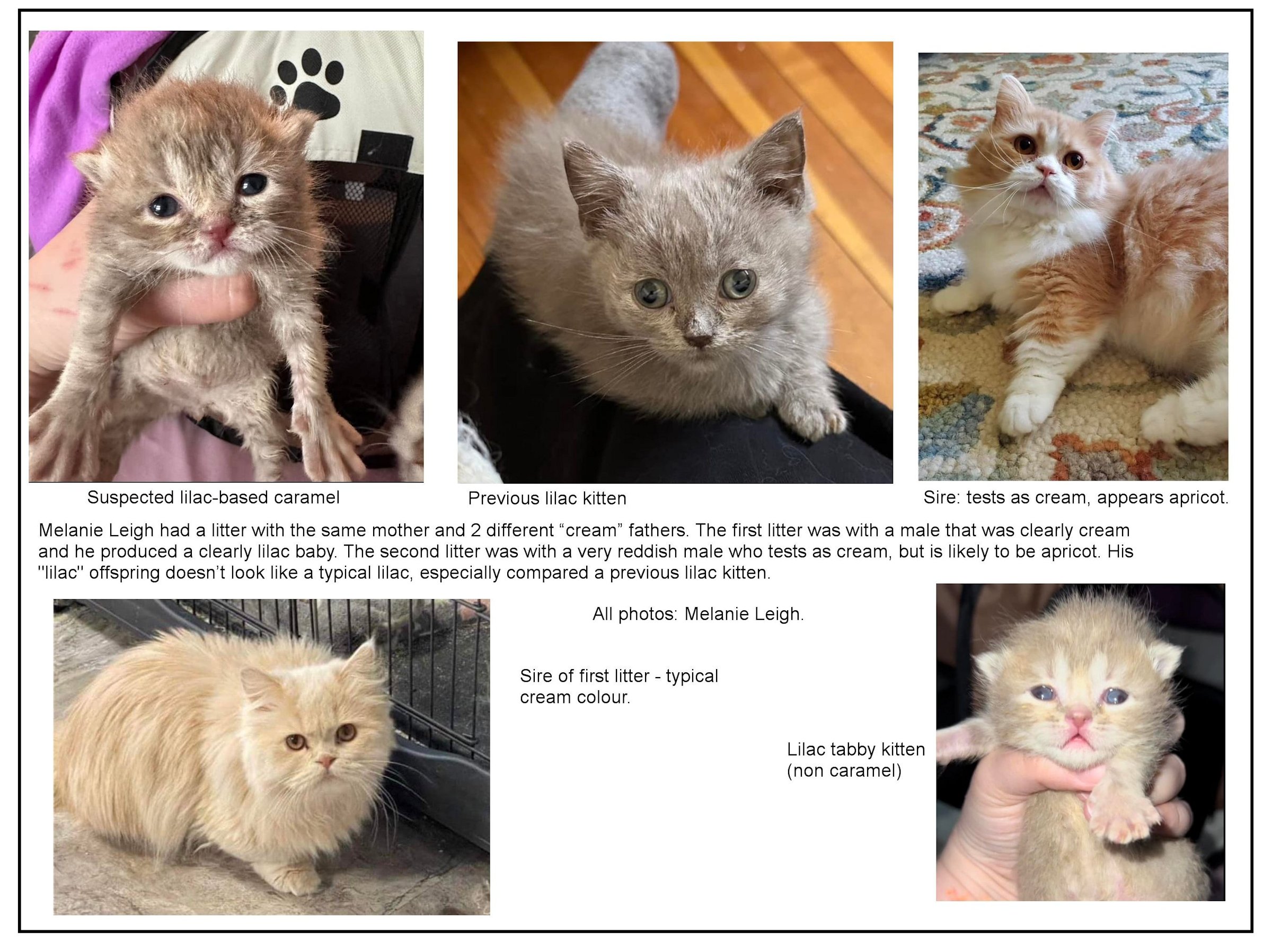
DILUTE MODIFIER GENE: CARAMEL AND APRICOT
The suspected Dilute Modifier gene (Dm) transforms dilute colours - blue, lilac, fawn, cream - into caramel (in black-based colours) and apricot (in cream cats). The Dilute modifier has no effect on the dense colours - black, chocolate, cinnamon, red - so cats with those colours can carry the Dm gene for generations and as long as there are no dilute offspring, no-one knows the cats carry Dm. Dense colours are epistatic to Dm. In dilute colours, Dm is dominant to non-Dm.
The effect was first noted in Oriental cats in the UK in the 1970's but is controversial in many registries because of a lack of scientific evidence for the molecular basis of a Dilute modifier in cats. It is an autosomal dominant gene with variable expressivity. Examining hairs under a microscope suggests there are structural differences between caramel and blue, and apricot and cream hairs.
British breeder Patricia Turner hypothesized in the 1970s that the Dm gene was dominant over the recessive wild dm allele. It is hard to prove this through line-chasing and genealogies because many registries do not recognise caramel and many cats are registered as the ordinary base colour (e.g. blue, cream) with no mention of caramel. In some registries, declaring a cat to be caramel on its pedigree means it can't compete at shows. This "hiding" of Dm cats means that a Dm kitten can seem to be born from non-Dm parents, especially when cats are transferred between registries!
Some registries regard caramel and apricot as merely the variable expression of dilute colours due to polygenes. Others regard the caramel/apricot as being transmitted in Mendelian fashion suggestive of a gene mutation that produces a darker, honey-tinted metallic sheen that is distinct from blue, lilac, fawn and cream. In tabbies, the metallic sheen is particularly visible on the neck, top of the head, tail, hocks and around the pads. These reflections may be less noticeable in kittens. Caramel and apricot have warmer tones than their base colour. The nuances of colour can be subtle and one of the main criteria used by judges to distinguish caramels and apricots from blue/lilac/fawn and cream is the metallic tint of these colours in daylight - something not always possible in a show hall.
|
ORIGINAL COLOUR |
DILUTE VERSION |
DILUTE MODIFIER VERSION OF THE DILUTE COLOURS |
|
Black |
Blue |
Caramel (UK: Blue-based caramel) |
|
Chocolate |
Lavender (Lilac) |
Taupe (UK: Lilac-based caramel) |
|
Cinnamon |
Fawn |
UK: Fawn-based Caramel |

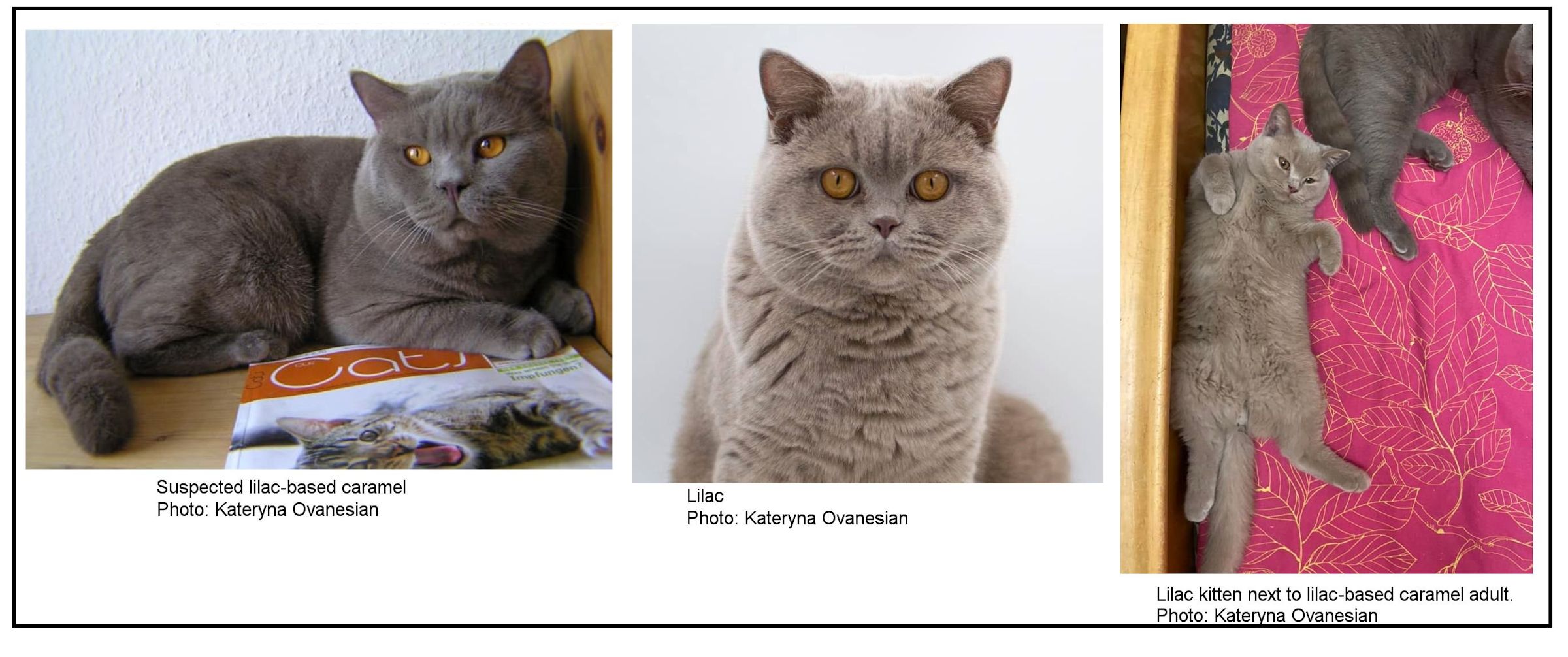
ORIGINS OF THE DILUTE MODIFIER
Although caramel and apricot colours were initially observed in the Oriental shorthair breed, they are now also seen in the Siamese, Balinese, Oriental Longhairs (aka Javanese or Mandarin), Tonkinese, Burmese, Birman and British Shorthair/Longhair and in derivatives of these breeds.
In Oriental Shorthairs, the Dilute modifier traces back to Scintasilva Sue in the 1960s. According to the Oriental Cat Association, in 1970 Pat Turner was notified of 5 or 6 cats and 2 kittens whose owner threatened to have them destroyed if they were not rehomed immediately. They included 2 imported chinchilla Persian females (Marisarni Retara and Marisarni Cindy) and Marisarni Retara's silvery coloured kittens from an accidental mating with a Siamese cat in the household (Marisarni Dandino). The silvery Siamese x Chinchilla kittens interested Turner because she had been investigating whether silver was a recessive allele at the colourpoint locus (the prevalent belief) or a different gene at a different locus (as we now know). Following discussions with geneticist Roy Robinson, she decided to bred from the hybrid kittens and test mated the 2 chinchilla females. Marisarni Cindy was bred to a black shorthair and Marisarni Retara was bred to a Lilac Pointed Siamese. Scinta Celeste (Scintasilva Celeste on databases) went to June Matthews but never produced offspring. Scintasilva Sue was mated to a red-point Siamese carrying blue (Pitapat Zeno). Meanwhile, Mary Dunnill confirmed that Marisarni Retara'-s 2 kittens were silver and they were registered as Scinta Celeste (Scintasilva Celeste on databases) and Scintasilva Sue.
One of Scintasilva's daughters, Scintilla Serene Sunset, was a black tortie silver shaded cat born in 1971. In 1973, breeder, Patricia Turner noticed that Scintilla Serene Sunset produced strangely coloured kittens. The colours weren't named at the time, but I will use the modern terms "apricot" and "caramel." In 1972, Turner had mated Serene Sunset to a red Siamese, Darling Red Rufus, and got apricot kittens. In 1973, Serene Sunset was bred to a lilac Siamese, Taurus Kay Kavalier, and produced more apricot coloured kittens.
In 1974 and 1975, Serene Sunset was bred to two chocolate males resulting in caramel kittens were produced. In 1974, Scintilla Dresden Rosa, daughter of Serene Sunset and Southview Trappist, was the first caramel kitten recorded, although the colour was not yet officially recognized. In 1974, the first apricot cat was recorded in England.

Click to see image in separate tab.
A male called Scintilla Apollo, unrelated to Scintasilva Sue, is behind other Dm lines. Tracing the cats back, and ignoring the anecdotal link to chinchilla Persians, both of these cats share a common ancestor in Camley Fudge.
Other theories for the origins of caramel and apricot all involved crossing a chinchilla Persian with an Oriental breed as part of the silver programme in Orientals. Three other American chinchilla Persians imported to the UK at the end of the 1950s were Kute Kit Silver Flyer, Kute Kit Silver Knick Knack and Silver Mesa Apache. To breeders, it seemed that the Dm gene arrived with the chinchilla Persians.
Somehow caramel got into Burmese lines. In 1974, a Burmese breeder visited Turner with a strange coloured Burmese female. The colour looked the same as that of Dresden Rosa, born that year. Both breeders were convinced that the Burmese female was caramel, but she was registered as lilac to avoid any controversy over a new colour in the Burmese breed. A number of blue Burmese seemed to have a brownish tint along the back, suggestive of blue-based caramel.
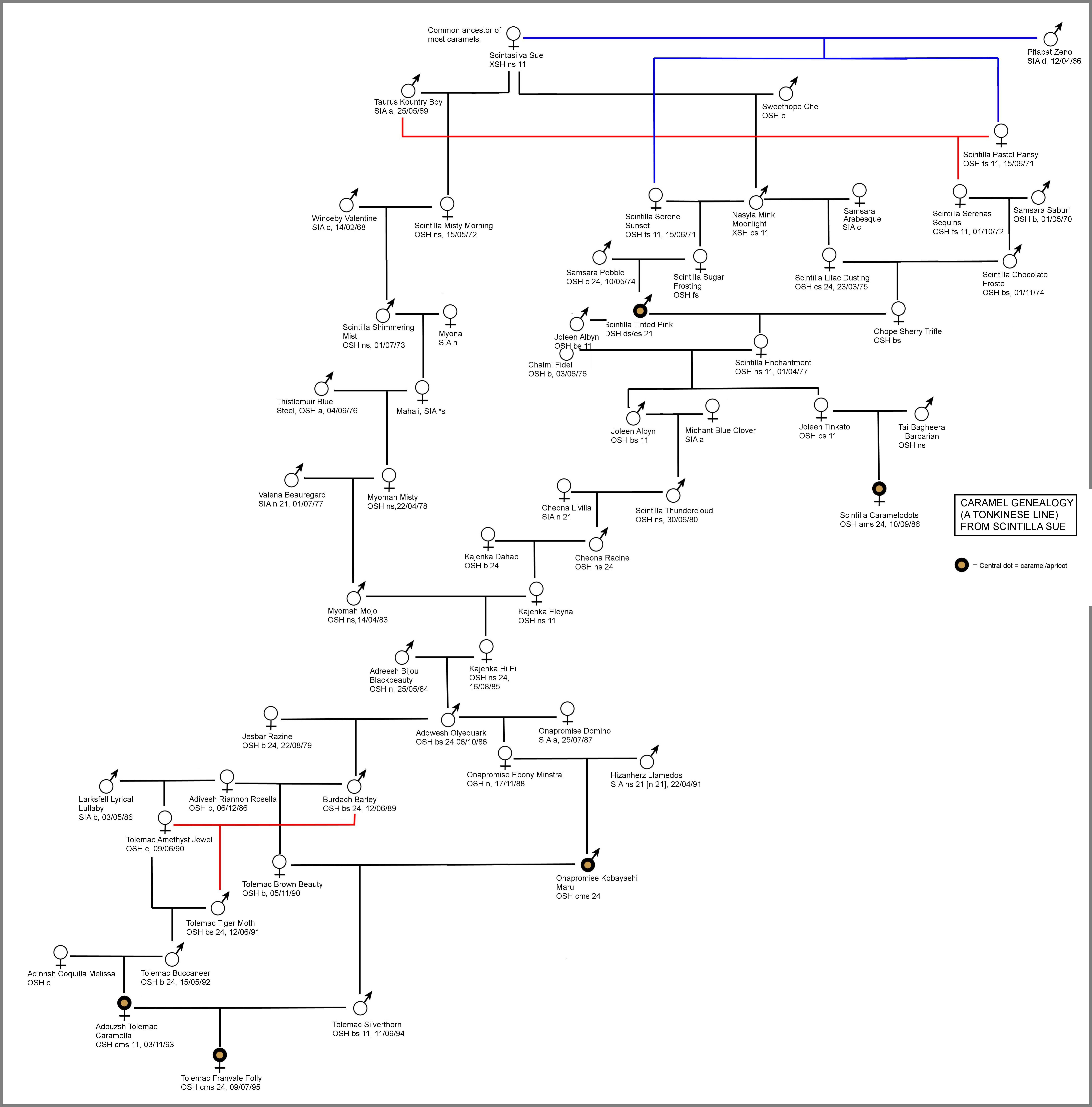
Click to see image in separate tab.
An anecdotal source of caramel was a silver tabby moggy that mated with a seal point Siamese named Macji Dom Dija, resulting in a silver tabby female called Tiggi. In 1960, Tiggi x Chancasta (seal point Siamese) produced a seal tabby point named Miss Tee Kat, whose descendants include many caramels. The unknown silver tabby has been linked (anecdotally) to a nearby chinchilla Persian breeder whose (possibly) free-roaming chinchilla Persian male could have sired silver tabbies with local cats. This is misleading because Macji Dom Dija is traceable to Scintilla Apollo, who is a common ancestor of other Dm cats.

Click to see image in separate tab.
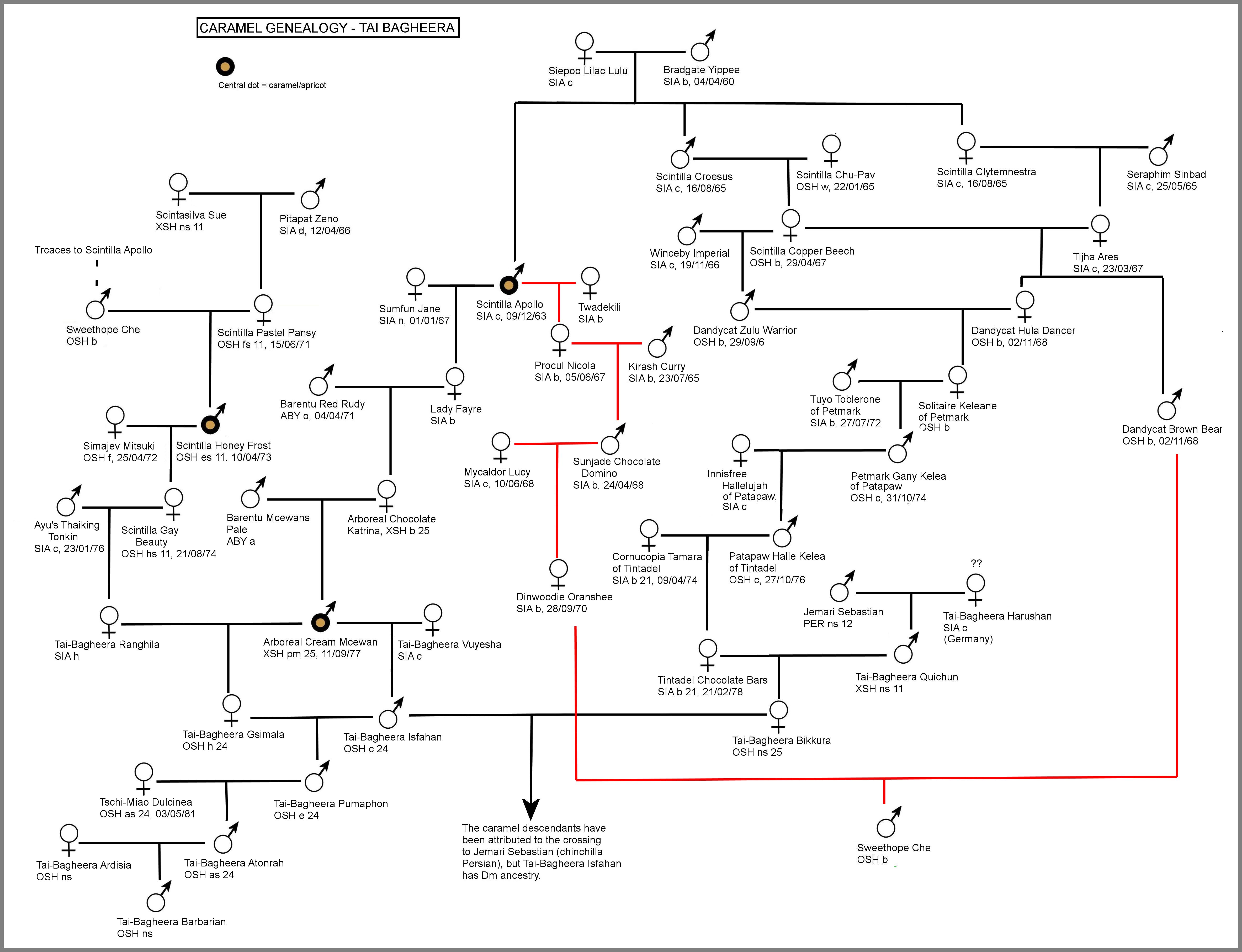
Click to see image in separate tab.
In Birmans, the first (or first well-known) cases of Dm were in cats from silver lines in New Zealand. Noelene Dally's Arodelle cattery began a programme to introduce silver from Arodelle Annetta, a blue silver tabby point shorthair of unknown ancestry. Annetta's line produced Fancypawz Polar Bear, a blue silver tabby point, in the 5th generation of the programme. Polar Bear's colour seemed strange: neither blue, lilac or fawn. In 2001, after leaving for the Kyat cattery, he was reclassified as a caramel silver tabby point by judges. (Scintilla Apollo is behind some Birman lines, but he is not linked to any of the Dm cats.)
The Belgian Leman Bleu cattery exported a few cats identified as caramel to France, including Alyby du Leman Bleu. The pedigree of Alyby du Leman Bleu shows an outcross to a silver shaded Persian, Temptation van de Weromeri. Most French breeders of Birman smoke and silver tabby points believe they have had caramel cats. Their cats do not trace to Scintilla Apollo and due to the date of the supposed introduction of Dm and the intermingling of the different silver lineages, it is difficult to identify the origins of Dm in the French Burmese.
With very few exceptions, the Birman tabby points come from silver Persian outcrosses, reinforcing the argument for a chinchilla Persian origin for the dilute modifier.
VARIABLE EXPRESSION
The Dilute modifier has variable expressivity. It produces a strong effect in some cats and much less in others. This produces a spectrum of caramel and apricot shades. This variability is what makes some breeders, judges and registries consider the "modified" colours to be the result of natural variation produced by polygenes.
Blue-based Caramel - Gray/brownish colour darker than lilac, even resembling "mud". Metallic reflections may be noticeable. Purple to brown pads
Lilac-based Caramel - Gray/brownish colour going towards warm honey-coloured tones. In young colourpoints, the "point" colour develops more quickly than in lilac cats. Metallic reflections may be noticeable. Pads darker than in a lilac cat, more chocolate in colour, with chocolate-coloured hairs between the pads in young cats.
Fawn-based Caramel - Much warmer colour than fawn, chocolate red going towards cinnamon with blue reflections. Caramel colourpoint cats on a fawn base are paler than caramel cats on a solid fawn base but are easily distinguished from fawn point cats. Metallic reflections may be noticeable. This colour is rarer than other caramels. Mauve-coloured pads except in "point" individuals where the nose and pads are pink.
Apricot Warm, slightly pinkish cream colour whereas in the cream cat the cream is rather "powdery". Metallic tint more noticeable with maturity especially on the head, legs and around the pads. Pads are pink.
Caramel adds an unmistakable (to experienced eyes) brownish/mushroom tone to the base colour and a silver sheen to the paws and the the ground colour of some tabbies. It is harder to distinguish in the pointed patterns because the colour develops more slowly. An 18 month old "lilac point" can turn out to be a very brown lilac-based caramel point at 4 years old.

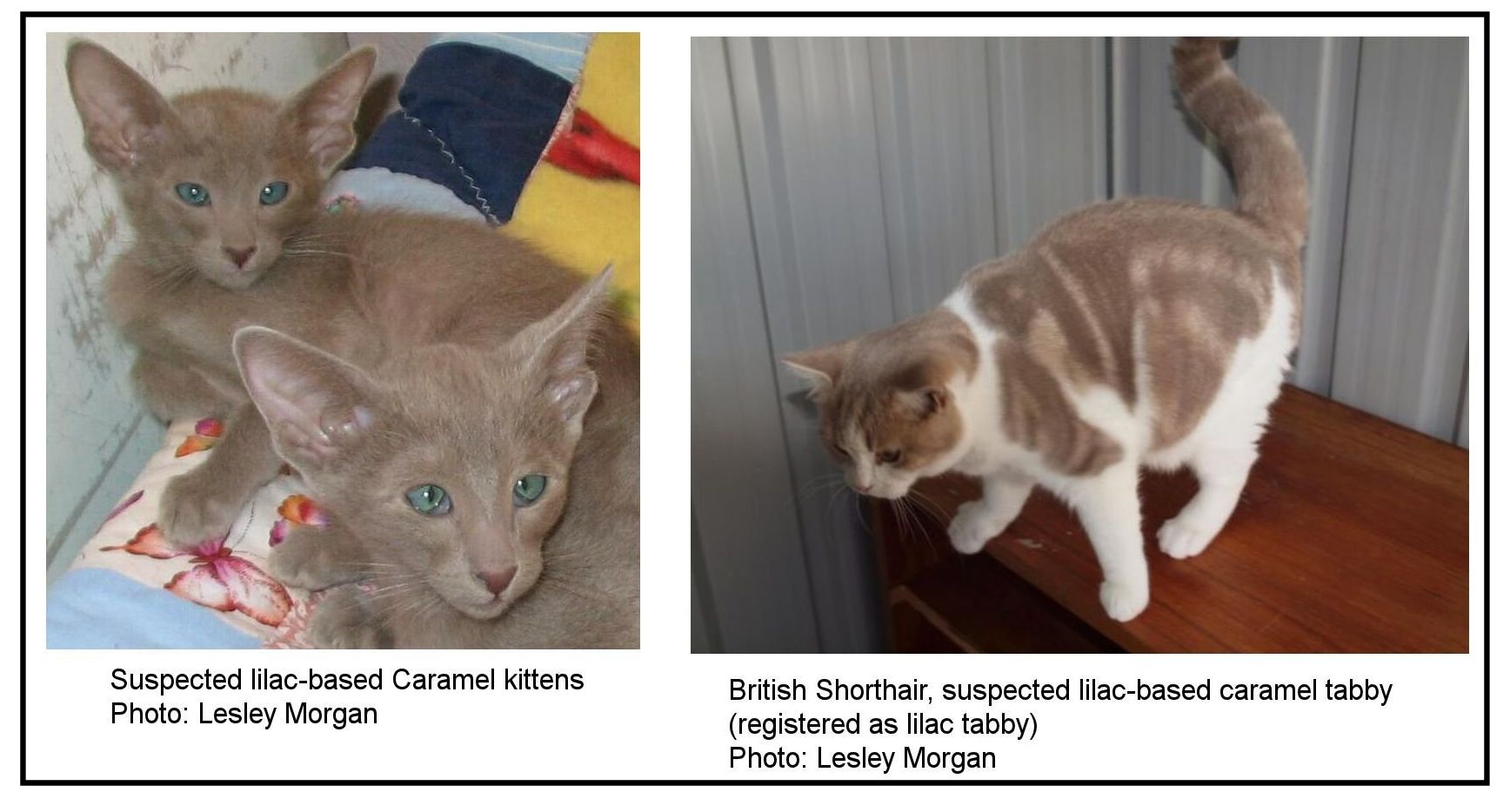
CONFUSION WITH "BARRINGTON BROWN" & THE CHINCHILLA MYTH
According to Turner (who was calling her cats "Oriental Pastels") the American early feline geneticist Don Shaw called the caramel colour "Barrington Brown" and had first seen this effect in American chinchilla Persians. Turner was using American chinchilla Persians in her breeding programme.
Shaw viewed dilution as being due to the reduced amount of melanin present in the hair and not by the way pigment forms clumps in the hair. A type of recessively carried brown colour was been reported in laboratory cats and termed "Barrington Brown", a cat with two copies of this gene had black pigment diluted as shown below. Some have suggested it is the same as Dm, but Shaw's data indicates a recessive mutation affecting black, chocolate and cinnamon. With no standard notation, Shaw used his own system. He believed chocolate was "dilution of black" (rather than a recessive allele) and referred to blue as "maltesing" rather than "dilution" but his breeding data indicates Barrington Brown was a recessive mutation.
The link to chinchilla Persians stuck and breeders began attributing the "funny colours" to various imported American chinchillas being used to introduce silver into Oriental shorthairs and Siamese. Line-chasing suggests a mutation in Siamese lines in Britain.
LINE-CHASING - A COMMON ANCESTOR
In a study by Florence Bonvarlet, for the 56 caramel/apricot cats for which samples were received, research was carried out using the Pawpeds database to find out the cats traced to Scintasilva Sue or to a cross with some other Persian chinchilla. Only 17 of the cats were on the Pawpeds database (it is voluntary): 4 Birmans and 13 Siamese, Oriental and Tonkinese cats.
The Birmans in the study all traced to a female chinchilla Persian born in June 1970 (I haven't line-chased this myself). 11 of the 13 Siamese/Oriental/Tonkinese cats, traced to Scintasilva Sue and Scintilla Serene Sunset. The remaining 2 Siamese/Oriental/Tonkinese, traced to Scintilla Apollo, born in 1963. Scintilla Apollo and Scintasilva Sue both trace to a chocolate Siamese named Camley Fudge born in 1956. One of Scintilla Apollo's descendants, Rivendell Rudi, was bred to Marisarni Retara, resulting in 2 daughters, so it is likely that there were other descendants of Rivendell Rudi that are not on the database. The same applies to Marisarni Retara who was probably bred to other descendants of Scintilla Apollo. Their descendants may reappear several generations later as "ancestry unknown" due to gaps on the database where pedigrees weren't submitted.

Click to see image in separate tab.
Bonvarlet found that the most likely mode of inheritance is autosomal dominant with variable expressivity. Because not all Dm cats were recorded as caramel/apricot (e.g. if a registry did not recognise Dm colours) and because many Dm cats appear to be missing from the Pawpeds database, she could not rule out an autosomal recessive exhibiting pseudodominance.
MICROSCOPY OF HAIR STRUCTURE
In dilute coloured hairs, the pigment granules are grouped in elongated oval clusters, with streaks of elongated pigment granules between them, rather than being evenly distributed along the hair shaft. In dilute modified hairs, pigment appeared to be grouped in round clusters, regularly distributed, and with no visible streaks of pigment. This suggests the Dilute modifier results in a difference in pigment deposition.
The microscopic study of caramel and apricot hairs showed the melanosomes to be smaller, more numerous, and a more regular spherical shape in caramel and apricot hairs than in the non-Dm dilute hairs.
Heather E. Lorimer, Lesley Morgan and Jamie Christian also did microscopy of caramel hairs. They saw no consistency in the caramel hairs. There were interesting things in the hairs, but no one thing in common. Some had clear tips as seen on Russian Blue hairs, some had a transparent outside of the hair shaft similar to, but less extreme than, glittered Bengal hairs. Some had more density of pigment than seen on most dilutes, others had clumpier pigment than seen on most dilutes, except creams where there is almost always a lot of clumping. If a Dm gene is discovered then it might turn out that only some of what is thought to be Dm really is Dm, while the rest is . . . something else.
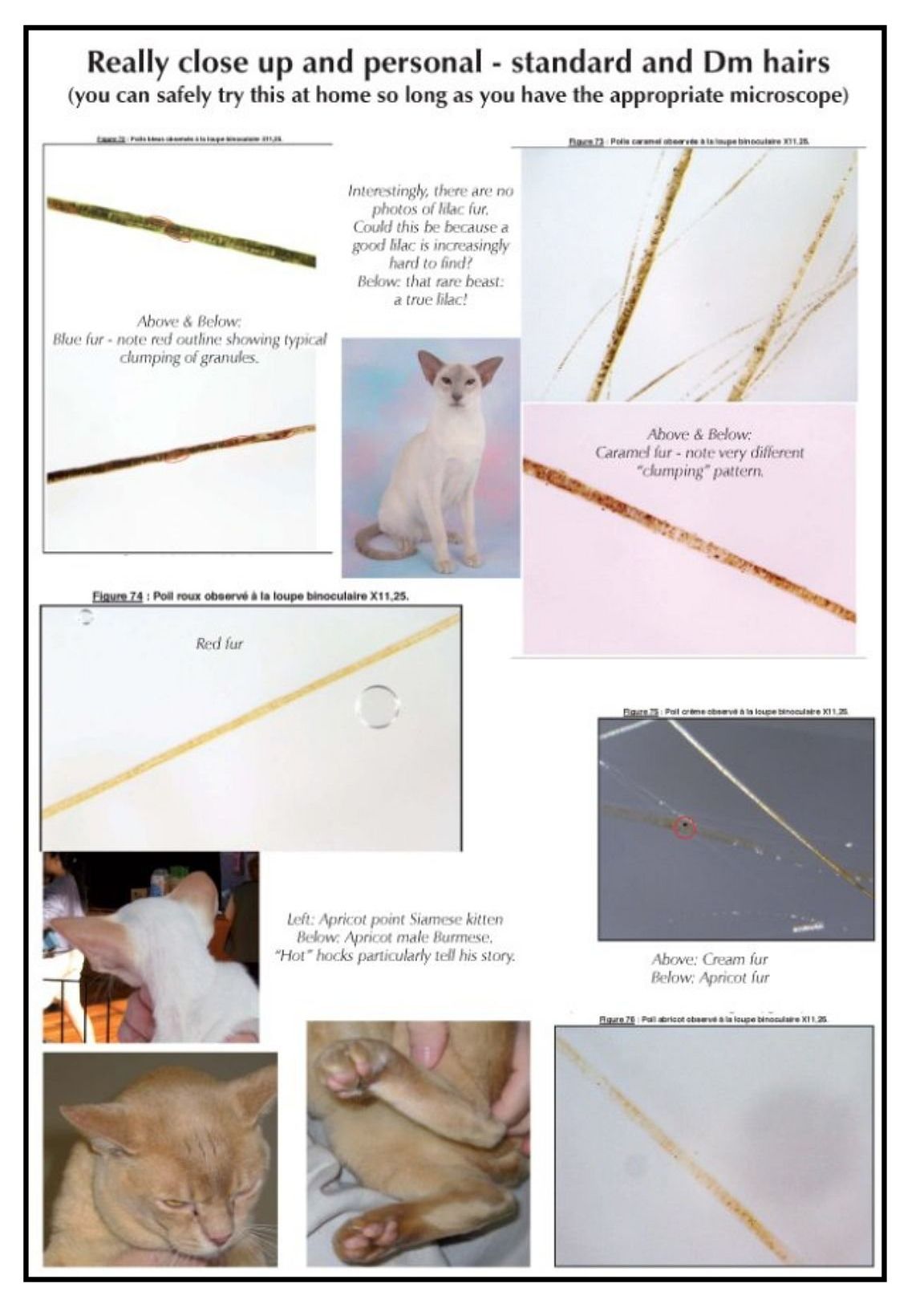
CANDIDATE GENE
One candidate for the Dm gene was a feline equivalent to the melanoregulin gene - Dilute suppressor (dsu) gene - in dilute colour mice, but Bonvarlet's DNA study found that the cat Dm locus was not homologous to the mouse dsu locus.

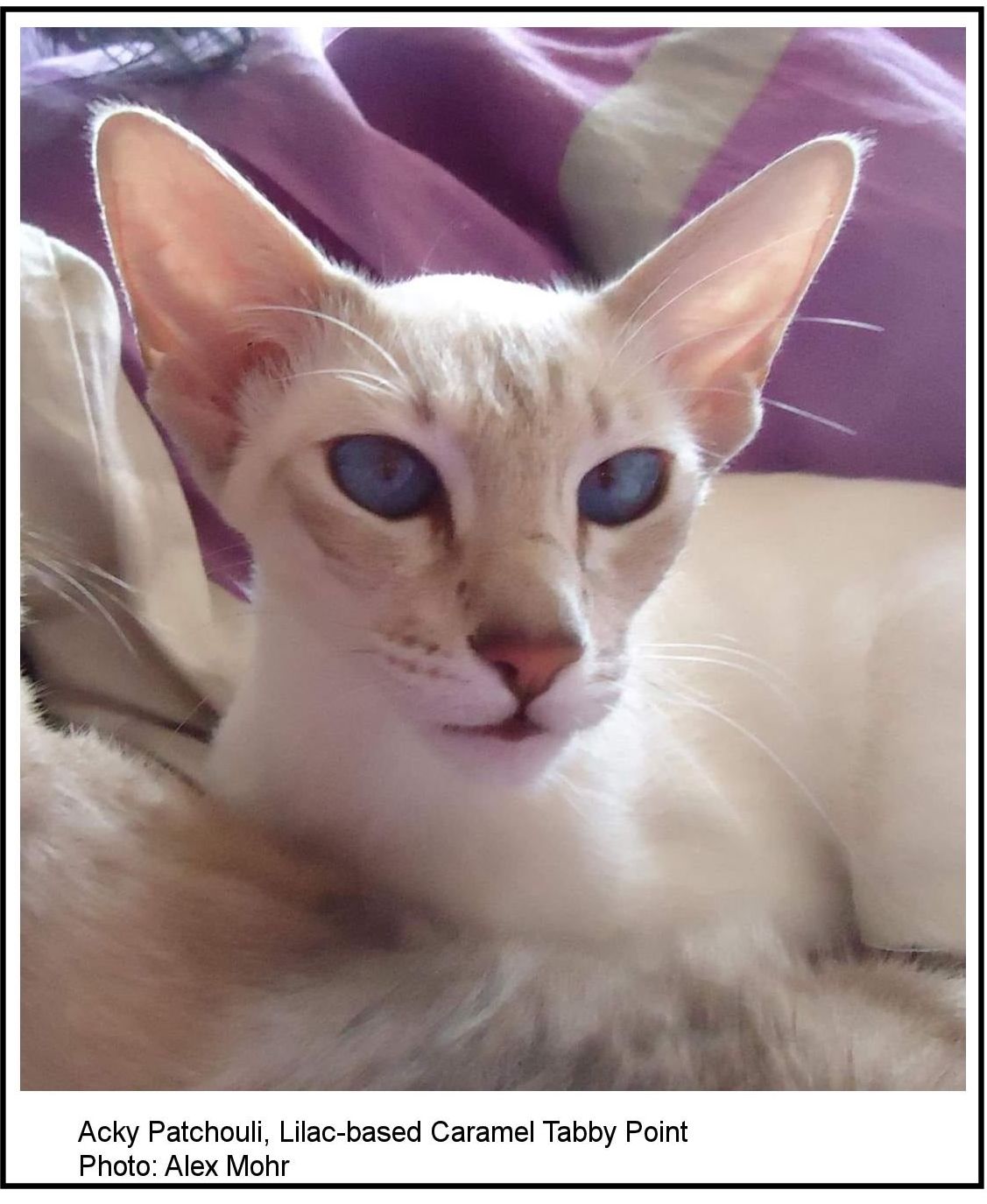
EMS CODES FOR CARAMEL
EMS: Caramel colours are shown by a combination of the base colour + "m". If the colour code already has 2 letters (e.g. ns, ay) there is a space between the base code and the "m".
am - blue-based caramel
cm - lilac-based caramel ("taupe")
em - apricot, based on cream
ea *m - apricot (blue based)
ec *m - apricot (lilac based)
ep *m - apricot (fawn based)
gm - caramel tortie (blue based)
jm - caramel tortie (lilac based)
rm - caramel tortie (fawn based)
pm - fawn-based caramel
*m - caramel, where the base colour is unknown
m* - caramel where the base colour is suspected e.g. am*
REFERENCES
APPENDIX 1. NEW COAT COLOR IN THE DOMESTIC CAT - PATRICIA TURNER, CAT GENETICS INVESTIGATION CENTRE
During investigation into the genetics of coat shading, matings were made which produced kittens of an unusual cafe au lait colour. At first, these kittens were considered to be lilac or lavender but, as they developed, it became apparent that they were not. The tone is similar to that of lilac or lavender but the colour is much warmer and more like milky coffee or caramel.
For the time being, the kittens have been named Caramels and test matings will be made to establish their genotype at the dilution locus before testing for other factors. The colour may be the dilute version of a milk chocolate mutant at the b locus, or it may be a colour in its own right and an expression of the p gene (Carter 1959); the bg gene (Kelly 1957) or the tp gene (Fielder 1952).
Two caramel kittens have been definitely identified and these are from the same dam but by unrelated sires. The dam is not caramel herself and is of known pedigree with no Caramel reported. Two other reports of Caramels have been made but not checked at the time of writing. Both these new reports are on kittens from daughters of the original dam mated with the sire of one of the two verified Caramels.
The first Caramel is Siamese, Caramel Pointed. The second Caramel is a silver. Caramel Silver. The unverified Caramels are both selfs.
References:
Carter, T.C. (1959) New Mutant. Mouse News Letter. 21, 40;
Fielder, J.H. (1952) The Taupe Mouse, J. Hered. 43 75-6;
Kelly, E.M. (1957) New Mutants. Mouse News Letter. 16, 36.
APPENDIX 2. THE BIRTH OF THE CARAMELS - PAT TURNER
My first venture into breeding unclassified colours was in 1962 when I first embarked on breeding towards the Foreign White. During the early years of the Foreign White I often found kittens of colours not immediately recognisable and in fact the vet I used in those days often accused me of making up colour names to fit the kittens (he was partly right). The Foreign White eventually became a pure Siamese variety and I then embarked upon breeding with the inhibitor gene (silver and smoke varieties). It was during the course of this inhibitor breeding investigation that I first 'stumbled' on the caramel colour.
I had a very beautiful second generation Oriental queen by the name of Scintilla Serene Sunset and she was a very important member of my cat family. She was a Tortie Shaded Silver carrying blue, chocolate, Siamese pointing, non-agouti, spotted tabby pattern and non-inhibitor. I first realised that she also had the capacity to breed completely new colours when, in 1972, she was mated to Champion Darling Red Rufus (Red Point). Among the litter were kittens I could only describe as 'apricot'. However, I assumed them simply to be off-coloured reds and thought no more about it until in 1973 I mated Scintilla Serene Sunset to Taurus Kay Kavalier (Lilac Point) and produced this same apricot colour again, both in self and smoke. To keep records straight I registered those I thought were apricot under the colour name apricot and continued to breed Serena (S.S. Sunset).
In 1974 a nephew of Serena sired two more apricot smokes to a Black/Red Tortie. The sire's name was Scintilla Honey Frost, himself an Apricot Smoke and later he sired another litter including two more. However, ever skeptical of anything more exciting than simple variation of red I thought very little more about them. They were so very pretty that I had absolutely no difficulty in finding homes for them.
Finally that same year Serena produced a litter of nine to Southview Trappist and among the nine were two Caramels. Obviously, I did not immediately realise that they were caramel. In fact, I only recognised that Siamese female as being of a completely new colour and registered the self as 'lilac'. The kitten I registered as Caramel was Scintilla Dresden Rose - now well known in the history of Caramel breeding. True to form I kept Rosa for myself and parted with all the more ordinary varieties. A number of breeders examined her and all were in agreement - she was nothing like anything they had ever seen before. I compared her with Lilacs, Blues, Chocolates and even with a rather oddly coloured Burmese owned by a Mr and Mrs Cooper. In fact we decided that their Burmese and Rosie WERE the same colour, but as the owners of the Burmese were advised to register as lilac and avoid any talk of more colours in Burmese, the possible development of Caramels in that breed were frowned upon. I do recall the name of the Burmese sire and I subsequently heard of a number of Burmese kittens with colour like my Rosie.
I believed the new colour to be a legacy from Southview Trappist because he had a rather unusual pedigree for those days having USA bred albino Siamese, UK bred Abyssinians and Siamese in his pedigree. He was longhaired and had a chocolate coat with light roots. In fact it was because his chocolate coat had light roots that Maureen offered him to me for breeding investigation. I soon solved the problem of inheritance of light roots and found that it was nothing to do with any possible recessive gene for smoke. By using Trappist I was also able to test mate my Orientals for longhair thus proving that my female breeding stock were not longhair carriers. But I realised that the albino Siamese ancestry (known in GCCF as recessive white and elsewhere as Dondo white) could have resulted in the birth of my odd Siamese colour. If my Siamese was a dondinese (a hybrid between recessive white and Burmese) then the points colour would be expected to be lighter. Maureen Silson had bred several such hybrids.
To test this theory I held a never-to-be-forgotten tea party. Peter Dyte, Jane Dyte, Roy Robinson, Julia May and Maureen all came down to Eastbourne and Maureen brought a Chocolate Point Dondinese. We put the two exhibits side by side and pondered. There was definite similarity in tone and a fairly close similarity in colour. I remember thinking that my kitten had a more opaque look to the colour, but there was no way I could have said that the two were clearly different. Peter Dyte and Roy Robinson are well known as geneticists with a special interest in cats and Jane and Peter Dyte had already seen the Burmese that had visited me earlier. They agreed my kitten looked the same colour as the Burmese and we agreed there was great similarity of colour between Maureen's chocolate point hybrid for Siamese/Recessive White - or Dondinese - and my Siamese. Eventually it was agreed that I would wait for the points colour on Rosie to develop fully and then register her under whatever colour name seemed appropriate.
I sold Scintilla Minueto as a pet, still registered as lilac and it was only much later that I realised she too was Caramel. If only I had been more perceptive when she was a kitten I would have avoided all the pondering about the possibility of Rosie being Chocolate Dondinese and saved myself the trouble of a number of test matings. However, the results of the test matings did go to prove indisputable that Rosie'-s colour was not chocolate diluted by recessive white and they did provide me with some very beautiful kittens.
I had great difficulty with the GCCF Siamese Registrar! I heard on the grapevine that my application to register a "Caramel" had been put to Executive Committee who were threatening to send the registrar to inspect me and the kitten before accepting my word. This caused great hilarity among my Sussex friends who thought it all a great joke. I was not quite so sure because no-one likes being inspected. I don't know whether the echoes of laughter reached the registrar but he didn't come and I got my registration certificate. I could understand why Burmese breeders decided to keep to the list of recognised colours when classifying their kittens, but at least I had the satisfaction of knowing that mine was registered as I knew her to be. With hindsight I realise that by the time I applied for Scintilla Dresden Rose as Caramel I had already bred 37 other Modifier or Dilute kittens (in six litters). The cat common to all pedigrees was Scintasilva Sue. She died of old age some time ago and her pedigree traces back to Bonavia Chinchilla Persians from USA bred cats imported into the UK after the second world war.
In 1975 I mated Scintilla Serene Sunset to her half-brother, Nasyla Mink Moonlight. She had eight kittens including one Caramel who I registered as Scintilla Karfy Ole. Karfy Ole went to John Harrison to breed Megrims (cats not fish). Another of the litter was Scintilla Hazy Sprite who went to Germany to Heide Stamm to breed Tai-Bagheeras. I made that mating because I knew that Mink Moonlight was not a carrier of recessive white and I was keen to find out if the colour could be produced without the gene. The results showed that it could and I now realise that Hazy Sprite was carrying the gene for she is behind most of the German/Dutch caramels.
Scintilla Dresden Rose was old enough to be mated in 1975 too and, in order to test for the possibility that Caramel was produced by the combination of Chocolate Point Siamese and recessive white, I mated her to Taurus Kay Kavalier (Lilac Point). I knew that if Caramel WAS Chocolate Siamese with Recessive white I could expect only Caramel Points, Lilac Points, very pale Lilac Points and normal Chocolate Points. I would not expect Blue Points. In fact the litter comprised two Blue Points, one Caramel Point and one Lilac Point. So - the colour was proved NOT to be a variation of chocolate. The Caramel Point was registered (without any trouble this time) as Scintilla Roseanna. She was a lovely kitten and went to a young woman who worked for Julia May until domestic circumstances changed and she came back to me.
1976 was an important year for Caramels because Scintilla Karfy Ole, Roseanna and Serene Sunset all had kittens. John mated Karfy Ole to a Havana of Betty Harrison's breeding - Harislau Flying. She had four chocolate kittens. Serene Sunset was mated to a Seal Point known not to carry blue or chocolate and produced five kittens. None were actually Caramel, but Scintilla Rosario (Seal Silver Tabby Point Siamese) proved to be a carrier of the gene concerned. Scintilla Roseanna was mated to Solitaire Tuku, a Havana known NOT to carry Siamese. She produced four Havanas. 1976 was also the year in which I mated Scintilla Serene Sunset to Bigoudi. Bigoudi was a blue-eyed European Albino owned by Roy Robinson, Peter Dyte and myself and bred in Belgium. But that is another story and I only mention it here in order to explain that the litter of eleven kittens included one who subsequently produced more Caramels.
John and I moved from Eastbourne in 1976 and some of my cats were neutered. Dresden Rose went to a new home in Yorkshire until I later heard, via the good offices of Doreen Watts, that she was not being cared for as I would like and she came back to me. I still had Serene Sunset and Roseanna. Roseanna was mated twice the next year, firstly to Scintilla Rosario and then to Solitaire Tuku. When Dresden Rosa came back she was mated to Vaiora Silver Knight, a Black Spotted Silver cousin, and from that mating came yet another Caramel Point Siamese.
Roseanna and Dresden Rosa were eventually neutered, and because of difficulties over registration of cats with Southview Trappist and his recessive white ancestry in pedigrees I discontinued breeding from that branch of the line and concentrated instead on the line from Scintilla April Blessing (a Foreign White bred Lilac Point) to Scintilla Rosario. By this time we lived in Milton Keynes and cattery accommodation was restricted to one stud house and run plus our living areas. Before I neutered Roseanna I was able to mate her to Smoke Falcon - a magnificent Black moggie who was left homeless when his owners moved from the next road to ours. I fed him, inoculated him, leukaemia tested him and used him for test mating before finally having him neutered and re-settling him on a small holding in West Sussex through the good offices of Min Flowers.
In 1979 a daughter of Roseanna (Scintilla Rosetta) was mated to Ch Coromandel Blue Beau, Blue Point. I planned to keep the resultant male Caramel as a stud, but he died of an unspecified virus infection before he could sire. Luckily I had Scintilla Koffee Kreme (Scintilla Rosario x Scintilla April Blessing) and he, when mated with a grand-daughter of Serena gave me four kittens, including a Caramel Spotted Silver male I registered as Scintilla Muted Mink. Scintilla Koffee Kreme also sired litters to two other queens and although there were no caramels several of the kittens proved to be carriers.
With the neutering of Rosa and Roseanna and the death of Robin (Blue Beau x Rosetta) the only Caramel Siamese of the line tracing back to Trappist was Rosetta. Because I had established that Caramel was not connected with the blue-eyed albino gene giving recessive white and because of registration difficulties with recessive white bred cats in GCCF, I sent Rosetta overseas and her pedigree continued with the overseas registration body I used at that time. I concentrated my Caramel breeding in the UK with the descendants of Rosario. I was lucky enough to get John Warwick of Ladymead to build me an additional stud house and to extend my cat runs so that I could again keep two studs and have plenty of fresh air for my queens, but I kept my cat family smaller than when I lived in Sussex. As I still had interests in Foreign Whites and was greatly involved with the development of Silvers and Smokes there was not room for more than one or two Caramels. I was also in partnership with Monica Buttery in a special line of Seal Point Siamese. So my Caramel breeding was restricted and I combined the Silvers, Smokes and Caramels whenever I could.
In 1981 I mated Michant Blue Clover (BP) to Scintilla Muted Mink to produce Scintilla Kalli Minkette, a Caramel Tabby Point Siamese. Amoureuse Melody, my Foreign Blue, was also mated to Muted Mink to give '-Big Minkie'-, otherwise known as Scintilla Pastelle Royale (Caramel Silver Tabby Point Siamese).
Unfortunately 1981 was a disaster year for the Scintilla cats. Despite precautions Kalli Minkette became Felv positive following her exhibition at the 1981 Progressive Show and before I was alerted to the problem the virus had passed to most of my other cats. All but three became Felv positive and, after repeated tests both at Glasgow and New York, I realised that I had no hope of saving even those who still looked fit. Subsequently two of my three survivors became positive after eight months quarantine following the 'final' all clear round of tests. By the end of 1982 I was left with only one of my cat family and a vets bill which it seemed impossible I would ever pay up. The one bright spark on the horizon was that my survivor was the Caramel Silver Tabby Point son of Scintilla Muted Mink. He had grown up in absolute isolation in one of my stud houses and I despaired of ever finding him a companion and carrying on with my cat breeding. In fact 1981 really marks the end of the Scintillas as competition cats. From that moment I decided never to become involved with regular showing of popular breeds of cats again and to concentrate my breeding on investigations of aspects of colour genetics that interested me. By so doing I felt I could still have the satisfaction of cats and kittens around me without the worries and risks involved in regular competition. Despite offers of kittens all over the world I '-went out of'- Seal Point Siamese and Foreign White breeding and kept away from shows.
In fact I only showed again when Scintilla Pastelle had sons of eight months - two gorgeous Caramel Tabby Point Siamese who I named Scintilla Caradon and Scintilla Caramellian. By 1984 I had bred two more Caramel females in a litter by Pastelle Royale and Caramellian began siring. He was mated several times including twice to Scintilla Silver Stanza and once to Scintilla Caramelodots, a Caramel Spotted Silver I had unexpectantly bred in a litter from an Oriental Shaded Silver and an Oriental Black Smoke given to me by my friend Heide Stamm of Germany. Unexpected though she was, I soon realised she had inherited the colour from her sire who traced his pedigree back to Scintilla Hazy Sprite exported ten years before and thus to Scintasilva Sue. The fact that Caramels can be bred from Blacks, Seal Points, Chocolates or Chocolate Points if both parents carry blue has been known to me for some time, but repeatedly I have been surprised when it happened. The latest such occurrence has recently been reported in a litter sired by a Chocolate Silver Oriental son of Scintilla Pastelle Royale.
My Caramel story now reaches the point when I decided to let the Caramels go to breeders who would have time, energy and money to blaze the trail for them at cat shows and take up the cudgels on their behalf with GCCF. From that point my own Caramel breeding was virtually halted, although I do have the gene in 'hiding' and I do hope to pull it out again in my Caramel Oriental, Harlequins and Tortie and Whites one day. During the years I spent sorting out the genetics of Caramel I exhibited on a number of occasions. In fact Scintilla Roseanna was exhibited in the 32x Siamese kitten class at a Siamese Cat Society Show. She won her class (being the only entry) AND a rosette and a silver plated dish given as a special by Mrs Montgomery. Unfortunately details of her pedigree incorrectly reported to GCCF led to her mother!! being disqualified from the show. I kept the letter as a souvenir for years, but I also kept the silver dish. I cannot remember what happened to the rosette. Soon after that the Breed 32x class was abolished.
I have never been entirely happy with the colour name of Caramel. It DID seem right as a description of Dresden Rosa but, of course, her genotype WAS also Dondinese. Once Caramel occurred in non-pointed cats the name no longer seemed so apt. By the time I considered changing it 'Caramel' had been adopted for the colour in a number of countries where descendants of Scintasilva Sue were bred. I contented myself by describing it as a bluish toned fawn in the Standard of Points, but even that is not strictly accurate. I have always felt that Taupe would be a better name and in fact the most accurate colour description in a standard for Caramels reads, 'Bluish Taupe'. When judging at a Dutch show in 1987 I had the great pleasure of nominating a 'Bluish Taupe' Caramel kitten as Best Siamese/Oriental Kitten and was delighted when the other judges agreed and it won. Not surprisingly the kitten'-s pedigree went back through German cats to my Scintillas and Scintasilva Sue.
Recently there have been a number of Caramels exhibited at shows in the UK and some of these come from the Siamese lines I had 'suspected' before. On a number of occasions Kate Orr told me of apparently Caramel Point kittens of other pedigrees to my own so I make no claim to having 'invented' the colour. My only claims to Caramel fame are that I recognised it as something different, despite objections and obstacles registered it as something different and undertook the controlled matings necessary to unravel its inheritance.
The gene is dominant, but is only expressed in a cat that is otherwise blue, lilac, fawn or cream. Currently I have only identified Caramel and Apricot with any certainty. Caramel is Modifier of Dilute on an otherwise blue, lilac or fawn cat, and Apricot is Modifier of Dilute on an otherwise cream cat. I suspect that the difference between the blue, lilac and fawn based Caramels will be too small to classify just as the differences between the black and chocolate based red are too small or the blue or lilac based cream are too small. The quirk of inheritance which allows black (or seal), chocolate and red to mask the effect of Modifier of Dilute is what makes the Caramel so interesting. It is this quirk which has misled some breeders into thinking the gene to be recessive.
Virtually all the non-white Orientals I have bred since 1970 have a chance of carrying the Modifier of Dilute and it is fascinating now for me to trace pedigrees of new and unexpected Caramels back to cats which, to all intents and purposes are 'off the pedigree'; i.e. more than four or five generations back.
When I started the breeding programme in which Apricot and Caramel occurred I was in the habit of registering every cat I bred. But around the time that Dresden Rosa was born the GCCF began to refuse certain pedigrees for registration so that I was forced to keep records either in another way or with other registration bodies and this habit has continued through the years. As a result many of my Caramels and Apricots do not figure in the list of Scintilla cats I obtained from GCCF last year. However, it does include three hundred and forty-four with registered numbers, breed numbers, dates of births and registration numbers of sires and dams. If any HF&OCA member wishes to have a copy to research their own pedigrees I will be happy to obtain an extra one. Additionally I have data on 27 litters involving the Modifier of Dilute gene which is available should any member wish to have it.
My current breeding project has occupied me for the past five years and I have every hope that Caramel colour is still there, hidden by the chocolate, black, red and white more evident. Hopefully one day I will have a self coated Caramel female from another breeder and then I hope to '-hit the show bench'- with my Caramel and Apricot Tortie and Whites!